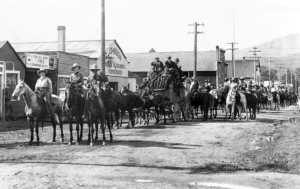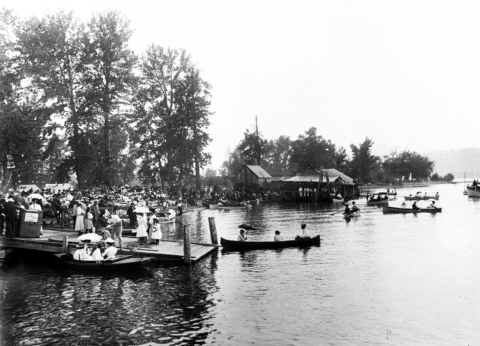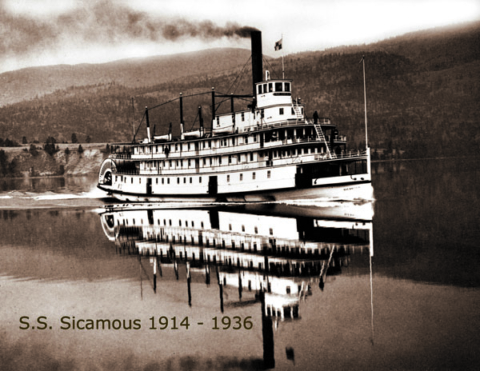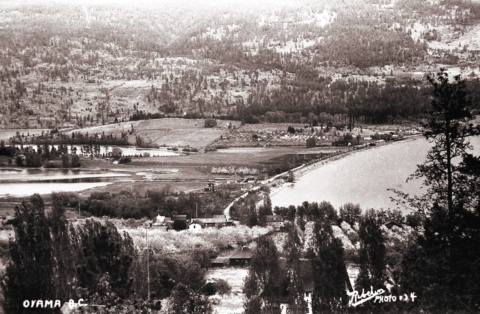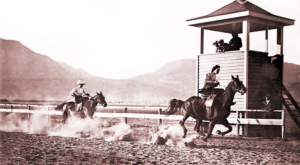
A Pictorial Essay by Brian Wilson
With all the research I do on a daily basis, there is one thing that has not shown up in any of the new, flashy histories of Kelowna. It’s the early horse racing and para-mutual betting events from 1895 to 1930.
There has always been racing events in colonial days with the first racetrack built in Vernon around 1900 where Kin Park is today. Kelowna’s track was built just after the turn of the century close to Knox Mountain. It later became the Fair Grounds.
After digging through papers and reports, as well as citizens reminiscences, I found very little on the sport of champions that was a fixture of British life.
There is plenty on “Riding Clubs”, “Gymkhanas”, and “Rodeos” and all the Dressage stuff.
But our Archive photo collection says differently. We have a great collection of race photos from the elite of Kelowna.
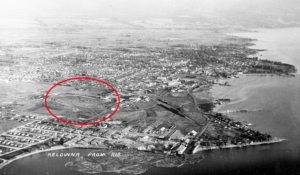
This aerial by Judd Ribelin was taken around 1938. It is particularly interesting, not just for the fair grounds but for the CN railyards and the sawmill housing. The mill was a huge employer.
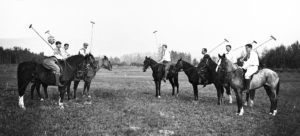
The photo above shows the Kelowna polo players preparing for a game against the Grand Prairie (Westwold) team in 1904. It was so successful that both Vernon and Kamloops formed teams.
Edith Weddell writes in 1962, “The game was played on a field where the CN tracks are. The umpire was T.C. Kerr and the Kelowna players were E.M. Carruthers, E.A. Barneby, Harold Stillingfleet and W. Barlee.”
There was so much support for the sport that the Kelowna Polo Club was formed. By 1906, a sports association came into being and was able to purchase the polo field from Dr. Boyce. Strangely, the field was still referred to as the ‘polo grounds’ right up to WWI, even though by then it was a full mile and a half (or 12 furlongs) racetrack.
I need to interject here with a note from information regarding inter-racial events in Vernon. The colonial riders just weren’t up to par with the native riders, so they had the races separately. The English riders learned over the years to not fall for the teasing of the Indian riders to get them to race. Even bareback, they could outdistance them all. It is legend that one Similkameen native even won riding his steed backwards.
This Kelowna event differs from Vernon in that Mr. Narcisse came over from Penticton. He was son of chief Narcisse and an accomplished rider. There is no record of how he placed in the races, but there was good money to be won.
Evidence of the segregated races is the last race on the 1906 Program below. Native women were referred to as “Kloochmen”, a Chinook dialect word, that was not very PC.
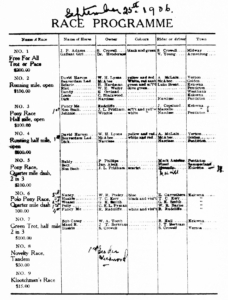
The property was developed as time went on to include a race tower, grandstands and paddocks.
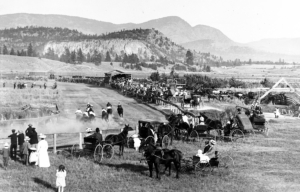
The Polo Club did quite well in competition, winning the Roper Challenge Cup (British Columbia provincial competition) two years in a row, 1909-10.
The Kamloops Sentinel reported, “The match between the Kelowna and the Kamloops polo teams took place on the Kamloops Club’s fine grounds on the Indian Reserve this past Saturday afternoon. The game was a fast one from start to finish and the visitors, by good combination play and the possession of better ponies than those of local players, won by a score of 8 to 3. This is the second consecutive time that Kelowna has won the Roper Cup Challenge, the team being the same as the one which was successful last year.”
The club put on many events over the years prior to WWI including Gymkhanas and holiday racing. Some of those races that we don’t hear much about in the modern realm are: Ladies’ and Men’s bending race, tennis ball race, Postilion race (lead an extra mount back over hurdles).
“The potato race was won by L. Casorso, first and Ian Cameron, second.”
But the declaration of war in Europe changed everything. The men put down the mallets and put on uniforms. As with the whole valley, they went to fight.
The Kelowna Sports Association just faded away and so did the polo grounds. The financial obligation could not be met, and the property reverted back to the first owner.
That was the end of organized racing and betting. It was gone forever.
The Kelowna Agricultural Fair Association formed in 1927, and the city constructed the fair grounds on the corner of Richter and Gaston Ave. The first regular fair was held in 1928 and continued into the mid-1930’s. The Great Depression took it’s toll and that too ceased.
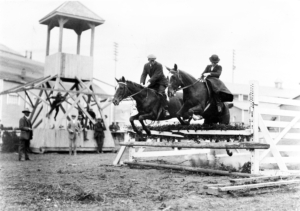
Here’s a couple of my favourites from Kelowna horse history: above – a wonderful photo by Huddy Hudson of dressage in 1908. Below – the Kelowna Fall Fair parade down Richter Street in the mid-20’s. Cowboy outfits and stage coaches replaced the British suit and tie. Editor
